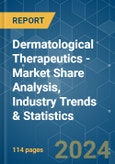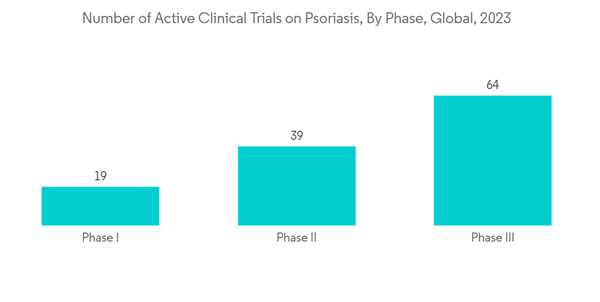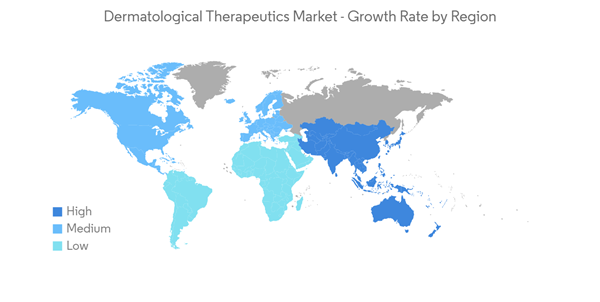The Dermatological Therapeutics Market size is estimated at USD 45.17 billion in 2024, and is expected to reach USD 71.66 billion by 2029, growing at a CAGR of 9.67% during the forecast period (2024-2029).
Globally, due to the high transmission rate of COVID-19, many countries worldwide have suffered and are continuing to suffer a major burden on their economy and healthcare systems. The manufacturing units of all healthcare-based companies were affected, and the transport was impacted badly across all developed and emerging markets during the COVID-19 pandemic. The dermatology market observed some indirect and direct impacts during the pandemic. For instance, according to an article published by PubMed Central in January 2021, a study showed that the COVID-19 outbreak had an adverse effect on most dermatology services, with a significant reduction in consultation time spent for chronic patients. Thus, the pandemic had a significant impact on the market growth. However, as the pandemic has subsided, the studied market is expected to have stable growth during the forecast period.
Some factors driving the market's growth include the growing burden of dermatology diseases, increased awareness levels of disease progression and etiology, and a rise in the elderly population. With the rise in the aging population, dermatological care is likely to receive particular attention. As people age, the risk of developing skin-related disorders increases due to factors such as changes in the connective tissue, reduction in the skin's strength and elasticity, and reduction in secretions from sebaceous glands.
For instance, according to the World Population Prospects 2022 Report published in 2022, the share of the global population aged 65 years or above is projected to rise from 10% in 2022 to 16% in 2050. By 2050, the number of people aged 65 years or over worldwide is projected to be more than twice the number of children under age five and about the same as that of children under age 12. Thus, the rising geriatric population is expected to enhance market growth.
Skin diseases have seriously impacted people's quality of life, causing productivity loss at work and other places and discrimination due to disfigurement. According to the Global Report on Atopic Dermatitis 2022 published by the International Eczema Council in 2022, about 223 million people were living with atopic dermatitis in 2022, of which around 43 million were aged 1-4. This shows the strikingly high prevalence in young children. In addition to the disease burden for the children and their caregivers, atopic dermatitis can also negatively affect the children's development, education, and work. Thus, the high prevalence and the rising burden of such dermatological diseases are expected to boost the market's growth.
The dermatological therapeutics market is anticipated to witness a lucrative growth opportunity due to collaborations, acquisitions, and new product launches. For instance, in December 2021, LEO Pharma Inc. announced that the US FDA approved Adbry (tralokinumab-ldrm) for the treatment of moderate-to-severe atopic dermatitis in adults 18 years or older whose disease is not adequately controlled with topical prescription therapies or when those therapies are not advisable.
Thus, the increasing burden of dermatological diseases, the rising geriatric population, and the increasing developments by key market players are expected to drive the market over the forecast period. However, serious side effects of certain classes of therapeutic drugs are expected to restrain the market in the near future.
The rising prevalence of psoriasis is a major factor driving the segment. For instance, according to the data updated by the National Psoriasis Foundation in December 2022, around 125 million people worldwide had psoriasis in 2022, almost equal to 2-3% of the total population. The source also stated that more than 8 million Americans had psoriasis in 2022. Thus, the high prevalence of psoriasis is expected to boost the adoption of dermatological therapeutics. As psoriasis is often associated with the elderly, the rising geriatric population is also expected to drive segmental growth.
As per the data published by clinicaltrials.gov, in February 2023, globally, approximately 325 ongoing clinical trials were being conducted for the treatment of psoriasis. These are expected to receive approvals for the treatment of the disease in the future, thus driving the segment's growth.
The new product launches, the focus of market players in expanding their market for dermatology therapeutics, and collaborations and acquisitions are anticipated to boost the segment. For instance, in December 2021, the US FDA approved the expanded use of Amgen Inc.'s drug Otezla to treat adults with mild to moderate plaque psoriasis.
Thus, due to factors such as the rising prevalence of psoriasis, the rising geriatric population, the increasing developments by key players, and the rising number of psoriasis clinical trials, the segment is expected to witness steady growth over the forecast period.
The rising prevalence of dermatological diseases is a major factor that is expected to boost the market in the region. For instance, according to the data published by the Asthma and Allergy Foundation of America in August 2022, around 16.5 million adults had atopic dermatitis (AD), with 6.6 million reporting moderate-to-severe symptoms in 2022. Thus, the high prevalence of such dermatological diseases is expected to boost the adoption of dermatological therapeutics in the region.
The rising geriatric population is also a major driver of the market. For instance, according to the data published by Statistics Canada in July 2022, around 7,330,605 people are 65 years of age or older in Canada, accounting for 18.8% of the total population.
The new product launches by key regional market players are also anticipated to boost the market's growth. For instance, in July 2021, Sol-Gel Technologies Ltd announced that the FDA approved its first proprietary drug product, TWYNEO (tretinoin/benzoyl peroxide) cream, 0.1%/3%, indicated for the treatment of acne vulgaris in adults and pediatric patients nine years of age and older. Similarly, in September 2021, Incyte announced that the US FDA approved Opzelura (ruxolitinib) cream for the short-term and non-continuous chronic treatment of mild to moderate atopic dermatitis (AD) in non-immunocompromised patients 12 years of age and older whose disease is not adequately controlled with topical prescription therapies, or when those therapies are not advisable. Thus, the rising product launches by key market players are mainly driving the North American market.
Thus, due to factors such as the rising prevalence of dermatological diseases, the rising geriatric population, and the increasing developments by key market players, the market is expected to witness steady growth in the region over the forecast period.
This product will be delivered within 2 business days.
Globally, due to the high transmission rate of COVID-19, many countries worldwide have suffered and are continuing to suffer a major burden on their economy and healthcare systems. The manufacturing units of all healthcare-based companies were affected, and the transport was impacted badly across all developed and emerging markets during the COVID-19 pandemic. The dermatology market observed some indirect and direct impacts during the pandemic. For instance, according to an article published by PubMed Central in January 2021, a study showed that the COVID-19 outbreak had an adverse effect on most dermatology services, with a significant reduction in consultation time spent for chronic patients. Thus, the pandemic had a significant impact on the market growth. However, as the pandemic has subsided, the studied market is expected to have stable growth during the forecast period.
Some factors driving the market's growth include the growing burden of dermatology diseases, increased awareness levels of disease progression and etiology, and a rise in the elderly population. With the rise in the aging population, dermatological care is likely to receive particular attention. As people age, the risk of developing skin-related disorders increases due to factors such as changes in the connective tissue, reduction in the skin's strength and elasticity, and reduction in secretions from sebaceous glands.
For instance, according to the World Population Prospects 2022 Report published in 2022, the share of the global population aged 65 years or above is projected to rise from 10% in 2022 to 16% in 2050. By 2050, the number of people aged 65 years or over worldwide is projected to be more than twice the number of children under age five and about the same as that of children under age 12. Thus, the rising geriatric population is expected to enhance market growth.
Skin diseases have seriously impacted people's quality of life, causing productivity loss at work and other places and discrimination due to disfigurement. According to the Global Report on Atopic Dermatitis 2022 published by the International Eczema Council in 2022, about 223 million people were living with atopic dermatitis in 2022, of which around 43 million were aged 1-4. This shows the strikingly high prevalence in young children. In addition to the disease burden for the children and their caregivers, atopic dermatitis can also negatively affect the children's development, education, and work. Thus, the high prevalence and the rising burden of such dermatological diseases are expected to boost the market's growth.
The dermatological therapeutics market is anticipated to witness a lucrative growth opportunity due to collaborations, acquisitions, and new product launches. For instance, in December 2021, LEO Pharma Inc. announced that the US FDA approved Adbry (tralokinumab-ldrm) for the treatment of moderate-to-severe atopic dermatitis in adults 18 years or older whose disease is not adequately controlled with topical prescription therapies or when those therapies are not advisable.
Thus, the increasing burden of dermatological diseases, the rising geriatric population, and the increasing developments by key market players are expected to drive the market over the forecast period. However, serious side effects of certain classes of therapeutic drugs are expected to restrain the market in the near future.
Dermatological Therapeutics Market Trends
Psoriasis Segment is Expected to Hold a Significant Market Share Over the Forecast Period
Psoriasis is a chronic autoimmune skin disease that speeds up the growth cycle of skin cells. It causes patches of thick red skin and silvery scales on the elbows, face, palms, knees, scalp, lower back, and soles of feet. The most common type of psoriasis is plaque psoriasis, and misguided T-cell attacks on the skin cause it. The rising prevalence of psoriasis, the increasing number of clinical trials for psoriasis drug development, and the rising developments by major market players are expected to boost the segment's growth.The rising prevalence of psoriasis is a major factor driving the segment. For instance, according to the data updated by the National Psoriasis Foundation in December 2022, around 125 million people worldwide had psoriasis in 2022, almost equal to 2-3% of the total population. The source also stated that more than 8 million Americans had psoriasis in 2022. Thus, the high prevalence of psoriasis is expected to boost the adoption of dermatological therapeutics. As psoriasis is often associated with the elderly, the rising geriatric population is also expected to drive segmental growth.
As per the data published by clinicaltrials.gov, in February 2023, globally, approximately 325 ongoing clinical trials were being conducted for the treatment of psoriasis. These are expected to receive approvals for the treatment of the disease in the future, thus driving the segment's growth.
The new product launches, the focus of market players in expanding their market for dermatology therapeutics, and collaborations and acquisitions are anticipated to boost the segment. For instance, in December 2021, the US FDA approved the expanded use of Amgen Inc.'s drug Otezla to treat adults with mild to moderate plaque psoriasis.
Thus, due to factors such as the rising prevalence of psoriasis, the rising geriatric population, the increasing developments by key players, and the rising number of psoriasis clinical trials, the segment is expected to witness steady growth over the forecast period.
North America is Expected to Have a Significant Market Share Over the Forecast Period
North America is expected to hold a significant market share due to increasing healthcare expenditure, growing awareness about skin diseases, and the strong presence of pharmaceutical companies.The rising prevalence of dermatological diseases is a major factor that is expected to boost the market in the region. For instance, according to the data published by the Asthma and Allergy Foundation of America in August 2022, around 16.5 million adults had atopic dermatitis (AD), with 6.6 million reporting moderate-to-severe symptoms in 2022. Thus, the high prevalence of such dermatological diseases is expected to boost the adoption of dermatological therapeutics in the region.
The rising geriatric population is also a major driver of the market. For instance, according to the data published by Statistics Canada in July 2022, around 7,330,605 people are 65 years of age or older in Canada, accounting for 18.8% of the total population.
The new product launches by key regional market players are also anticipated to boost the market's growth. For instance, in July 2021, Sol-Gel Technologies Ltd announced that the FDA approved its first proprietary drug product, TWYNEO (tretinoin/benzoyl peroxide) cream, 0.1%/3%, indicated for the treatment of acne vulgaris in adults and pediatric patients nine years of age and older. Similarly, in September 2021, Incyte announced that the US FDA approved Opzelura (ruxolitinib) cream for the short-term and non-continuous chronic treatment of mild to moderate atopic dermatitis (AD) in non-immunocompromised patients 12 years of age and older whose disease is not adequately controlled with topical prescription therapies, or when those therapies are not advisable. Thus, the rising product launches by key market players are mainly driving the North American market.
Thus, due to factors such as the rising prevalence of dermatological diseases, the rising geriatric population, and the increasing developments by key market players, the market is expected to witness steady growth in the region over the forecast period.
Dermatological Therapeutics Industry Overview
The dermatological therapeutics market is moderately fragmented. Due to the growth opportunities, many new players are emerging in the dermatological therapeutics market. Forthcoming patent expiries of major drugs are leading to increased competition, further driving the market studied, especially in the generic sector. The dermatological diagnostics and therapeutics industry is expected to grow tremendously, with several generic players controlling significant market share in the developing regions. Some of the market players include Amgen Inc., Bausch Health Companies Inc., Novartis AG, AbbVie Inc., and Almirall SA.Additional Benefits:
- The market estimate (ME) sheet in Excel format
- 3 months of analyst support
This product will be delivered within 2 business days.
Table of Contents
1 INTRODUCTION
4 MARKET DYNAMICS
5 MARKET SEGMENTATION (Market Size by Value - USD million)
6 COMPETITIVE LANDSCAPE
Companies Mentioned (Partial List)
A selection of companies mentioned in this report includes, but is not limited to:
- Abbvie Inc. (Allergan PLC)
- Almirall SA
- Amgen Inc.
- Bausch Health Companies Inc.
- Galderma SA
- GlaxoSmithKline PLC
- Johnson & Johnson
- Novartis AG
- Pfizer Inc.
- Bristol-Myers Squibb Company
- LEO Pharma AS
- Eli Lilly and Company
- Sun Pharmaceuticals Ltd
- Aclaris Therapeutics Inc.
- Aurobindo Pharma Ltd
Methodology

LOADING...










